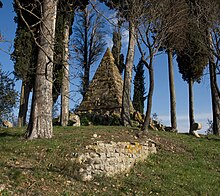You can help expand this article with text translated from the corresponding article in Italian. (September 2012) Click [show] for important translation instructions.
|
| Battle of Montaperti | |||||||
|---|---|---|---|---|---|---|---|
| Part of the conflict between the Guelphs and Ghibellines | |||||||
 | |||||||
| |||||||
| Belligerents | |||||||
|
Ghibellines:[1][2] Siena Manfred of Sicily Pisa Terni Florentine exiles |
Guelphs:[1][2] Florence Lucca Bologna Prato Orvieto San Gimignano San Miniato Volterra Colle Val d'Elsa | ||||||
| Commanders and leaders | |||||||
|
Provenzano Salvani Farinata degli Uberti Giordano d'Anglano Ildebrandino Aldobrandeschi [5][6][7] |
Jacopo del Naca † Niccolò Garzoni † [5][6][7] | ||||||
| Strength | |||||||
| 17,000 troops[5][6][8] | 33,000 troops[1][5][6] | ||||||
| Casualties and losses | |||||||
|
600 killed[9] 400 wounded[9] |
2,500 killed[1][6][10] 1,500 captured[1][6][10] | ||||||


The Battle of Montaperti was fought on 4 September 1260 between Florence and Siena in Tuscany as part of the conflict between the Guelphs and Ghibellines. The Florentines were routed. It was the bloodiest battle fought in Medieval Italy, with more than 10,000 fatalities. An act of treachery during the battle is recorded by Dante Alighieri in the Inferno section of the Divine Comedy.
- ^ a b c d e Leo, Heinrich (1830). Geschichte der italienischen Staaten: Vom Jahre 1268–1492. Hamburg.
- ^ a b Brockhaus (1838). Blätter für literarische Unterhaltung: Vol. 2. Leipzig.
- ^ a b Gebrüder Reichenbach (1841). Allgemeines deutsches Conversations-Lexicon: Vol. 10. Leipzig.
- ^ Kopisch, August (1842). Die Göttliche komödie des Dante Alighieri. Berlin.
- ^ a b c d Busk, Mrs. William (1856). Mediæval popes, emperors, kings, and crusaders: Vol. 4. London.
{{cite book}}: CS1 maint: location missing publisher (link) - ^ a b c d e f von Raumer, Friedrich (1824). Geschichte der Hohenstaufen und ihrer Zeit: Vol. 4. Leipzig.
- ^ a b Damberger, Joseph Ferdinand (1857). Synchronistische Geschichte der Kirche und der Welt im Mittelalter: Vol. 10. Regensburg.
{{cite book}}: CS1 maint: location missing publisher (link) - ^ Lau, Dr. Thaddäus (1856). Der Untergang der Hohenstaufen. Hamburg.
{{cite book}}: CS1 maint: location missing publisher (link) - ^ a b Villari, Pasquale (1905). I primi due secoli della storia di Firenze. Florence.
{{cite book}}: CS1 maint: location missing publisher (link) - ^ a b Trollope, Thomas Adolphus (1865). A history of the commonwealth of Florence: Vol. 1. London.
{{cite book}}: CS1 maint: location missing publisher (link)